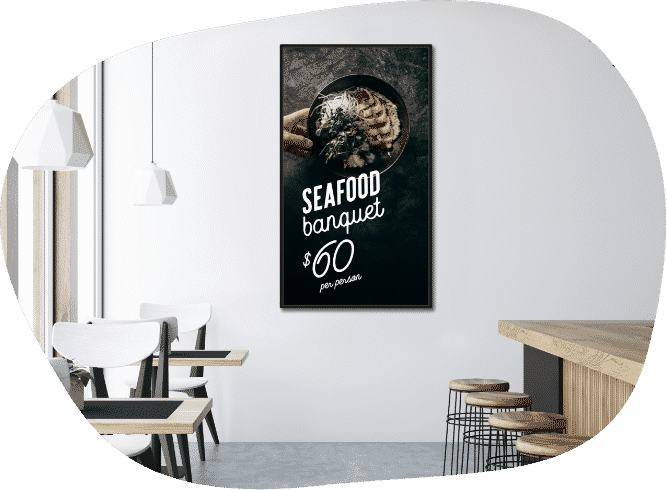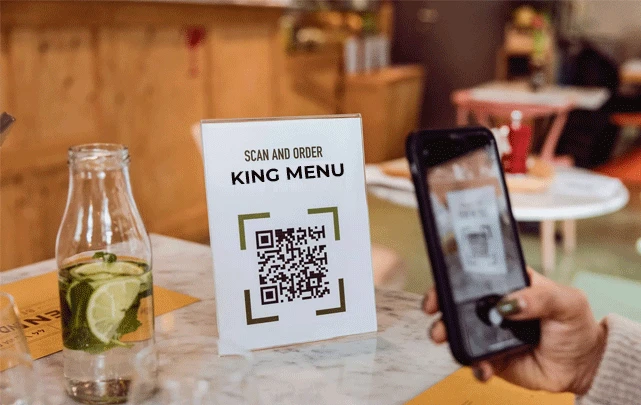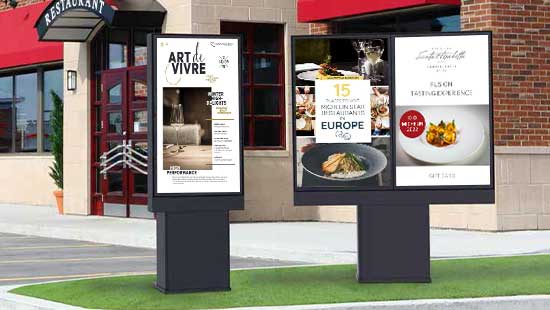In the competitive arena of seafood restaurants, the seafood restaurant menu board will predetermine the mood of a visitor before he or she sits down. Whether it is a clear fish restaurant menu board with the catch-of-the-day of the day or an interactive digital signage software-enabled touchscreen, the latest in restaurant digital signage makes the sea come alive. Using Nento digital signage products, seafood restaurants will be able to change on the fly, show seasonal specials, change prices, and create immersive experiences that will increase engagement and sales.
The Importance of Signage in a Seafood Restaurant
Dynamic Menus for Fresh Catches
Seafood is infamously unstable, with menus shifting with what the market has to offer and what is in season. The printed boards are very fast outdated, and this disappoints the customers. Digital signage services through a seafood restaurant menu board can enable you to change the menu board in seconds to replace fresh tuna tartare with grilled mahi mahi so you can be accurate and limit waste.
Elevating the Dining Ambiance
Visitors do not want to see a scribble on a chalkboard; they want visual storytelling. A digital menu board can exhibit slow-motion video of oysters being opened or a 4K picture of a steaming bouillabaisse, which supports the restaurant’s quality seafood. Nento Free templates for restaurants contribute to a neat marine-style appearance on all screens.
Cost-Effective Updates
Conventional reprints of specials incur huge expenses on a weekly basis. In comparison, the Nento cloud-based digital signage product allows you to change prices, delete out-of-stock items, and plan tomorrow’s lobster roll promo all on your tablet. Such a seafood restaurant signage solution can cut down the printing cost and employee labor associated with manual menu changes.
Seafood Restaurant Menu Board: Real-Time Menu Control
Hand-written chalk specials are a thing of the past. Using the seafood restaurant menu board by Nento, operators are instantly able to control all listings and prices. The intuitive cloud dashboard allows you to edit menu items, such as adding a new entree of blackened swordfish or removing an item, such as smoked salmon dip, and those changes are pushed live to all the in-venue screens. There are high-resolution pictures beside each menu item that stimulate visual interaction, and multiscreen installations enable the presentation of appetizers, entrA©es, and wine combinations at the same time. With such a digital menu board, your clients are guaranteed to see the latest items, be it fresh cod or crispy calamari, at a single glance.
Interactive Experiences with Digital Signage
Go further with Nento interactive digital signage software to engage the guest. Touchscreen kiosks encourage customers to investigate supply chain information, click on icons to see where the lobster on a given day was caught, and sort foods by allergy or dietary restriction. QR code on your seafood restaurant menu board would allow customers to scan a meal to see wine-pairing recommendations or nutrition information on their phones. When combined with high interactivity, digital signage for restaurants helps seafood establishments build trust and transparency, which is essential in selling perishable seafood.
Visual Appeal with Digital Menu Boards
An attractive menu board on a digital screen is not only words on a screen but a visual feast. The digital signage services of Nento also feature professionally designed Free templates for restaurants based on seafood themes: wave-like layouts, pearl-white text fields, and accent colors resembling sea foam. Switch your digital menu board between happy hour oyster specials, a backstage look at the fish being filleted by chefs, or the next seafood festival. This changing content does not only makes people wait longer but also leads to incremental sales of items being advertised.
Complete Digital Signage Services from Nento
It requires professional assistance to control a variety of displays. The end-to-end digital signage solution offered by Nento includes strategy, hardware installation, and continuous technical support. We can set up your seafood restaurant signage system so that it can schedule menus, morning market boards, afternoon specials, and evening chef recommendations and integrate with back-of-house POS systems with ease. What comes out of it is a stress-free atmosphere in which you are concerned with serving great seafood.
Tailored Digital Signage Solutions
There is no single seafood restaurant, and that is why Nento digital signage solution can be completely customized. Whether it is a casual fish-and-chip stand or a luxe oyster bar, our platform will grow with the demands on you. Select between straightforward single-screen digital menu board systems and multiscreen deep-immersive walls. Use our reseller digital signage program to white-label all these solutions to get partnership opportunities and provide these robust digital signage solutions to the restaurant industry under your brand name.
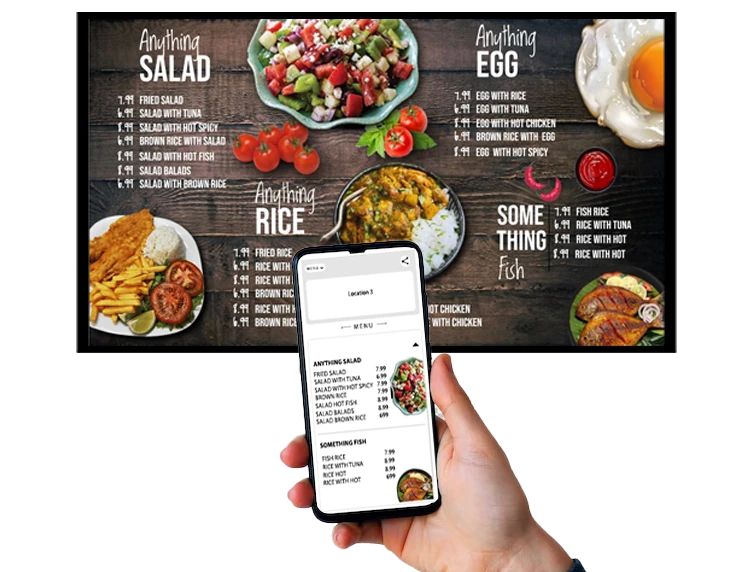
Digital Signage for Restaurants That Serve the Sea
Automated Promotional Scheduling
Using the digital signage solution of Nento, seafood restaurants are able to automate specific promotions in their seafood restaurant signage. Create a recurring event, such as a special happy hour of lobster or a weekend-only offer of Crab Cake Combo, on the cloud-based dashboard. These digital signage services will guarantee that your seafood restaurant menu board changes at the right time, every time, without any manual interference, and it will also ensure that there is consistency between all the screens.
Split-Screen Layouts for Dynamic Presentation
Take your digital menu board to the next level using split-screen designs to show several streams of content at once. Present your main menu on one side, and the other panel is running live weather, local fish market prices or digital signage software-driven social media feeds with guest reviews. This tiered signage will keep customers updated and involved and make your seafood restaurant signs a multi-purpose information center.
Seamless Brand Storytelling
The signage of your seafood restaurant must represent the story of every catch. With the help of the Free templates of Nento in restaurants, create screens with a combination of high-impact visuals, e.g., video clips of fish markets or sustainability programs, and concise messages explaining your sourcing practices. By adding your brand narrative to each slide, your restaurant’s digital display will be more than a menu board: it will become a powerful digital spokesperson for your seafood philosophy.
Free Templates for Restaurants: Design Made Simple
Not all operators have a resident designer. This is why Nento offers an extensive collection of Free templates for restaurants, namely designed to suit a seafood restaurant. Change colors, replace your logo, and simply drag and drop new images with a few clicks. These templates will make your seafood restaurant menu board and interactive displays consistent in branding without any special design expertise.
Measuring the Impact of Your Seafood Restaurant Signage
It is important to know the effectiveness of your seafood restaurant signage so that improvements can be made in the continuous process. Monitoring the essential metrics, which are enabled by your digital signage system, allows you to adjust the content, improve menu boards, and increase ROI.
Impression and Dwell Time
Embedded analytics on your digital signage services can tell the number of times that the seafood restaurant menu board is watched and the duration guests spend on each slide. Impression numbers on your catch-of-the-day ads are high, and that is an indication of good location and layout.
Engagement Rate
Kiosks with interactive capabilities, such as scanning a QR code or tapping a touchscreen on your interactive digital signage software, will tell you which recipes or sourcing stories are the most popular. When your lobster or oyster filter screens have a high engagement rate, it means that the guests are interested in it.
Sales Uplift
Compare the sales figures of your POS before and after new campaigns of digital menu boards. When grilled salmon orders increase after you specifically upsell with a video on your seafood restaurant signage, then you have a winning content type to replicate.
Content A/B Testing
Test various digital menu board templates side-by-side, say a template that communicates sustainability-related messages and one that communicates interviews with the chef, with Nento Free templates available to restaurants. Find out which version elicits more click-throughs or purchases, and implement the best one on every screen.
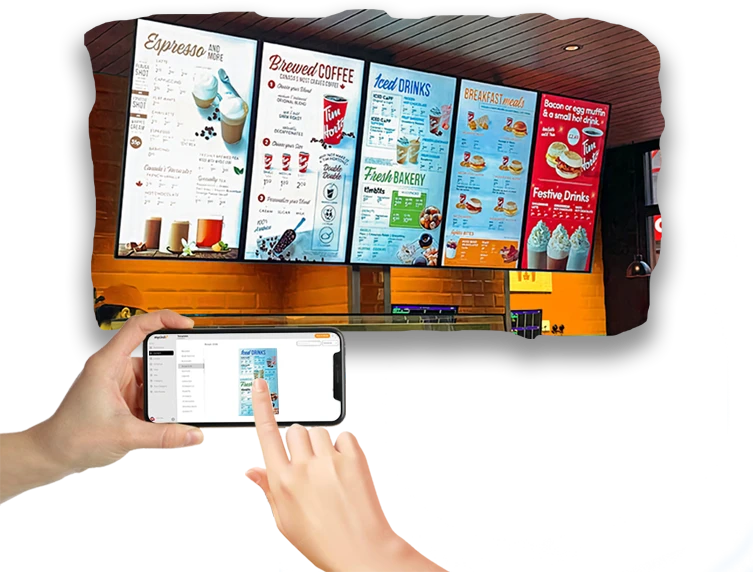
Make Waves with Your Seafood Restaurant Signage
Eating seafood is all about seeing, tasting, and hearing, and your seafood restaurant signage needs to be that rich. A complete digital signage solution with Nento allows you to create immersive seafood restaurant menus, use interactive digital signage software, and take advantage of digital signage services to keep all your display screens as fresh as your daily catch. Are you ready to make your walls look like oceanfront? Jump in with Nento and have your signage attract new customers and loyal followers.
FAQs
How does digital signage improve a seafood restaurant’s customer experience?
Through the provision of an up-to-date menu, quality photographs of seafood, and interactive sourcing and matching details, seafood restaurant signage can be informative and interactive.
Can I update seafood menus daily with minimal effort?
Yes. Nento cloud dashboard allows you to edit menu items, pricing and imagery in real-time- no more manual reprints and errors.
What kinds of content can I display on seafood restaurant screens?
It could be daily catch photos, promotional videos, chef interviews, environmentally sourced stories, and digital signage services-powered animations.
Do I need technical knowledge to use Nento’s signage system?
No. Our digital signage platform is simple to edit, includes intuitive drag-and-drop editing, guided onboarding and set-up, and is easily usable by users of all skill sets.
Can Nento signage systems integrate with restaurant POS systems?
Absolutely. Real-time seamless integration of digital signage in restaurants updates the menu prices and inventory in real-time, minimizing ordering mistakes and streamlining operations.

